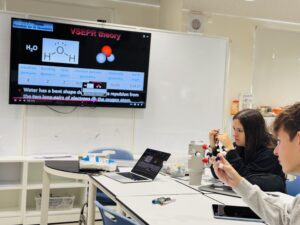In our Grade 11 chemistry class, students are currently engaged in their second unit on molecular structure, where they have thoroughly covered essential concepts related to ionic bonding and structures, as well as covalent bonding and both giant atomic and molecular structures. This week, the focus shifted to exploring intermolecular forces, including London dispersion forces, dipole-dipole interactions, and hydrogen bonding, which are crucial for understanding the physical properties of substances. To reinforce these concepts, students spent time in the lab modeling various molecular shapes using the Valence Shell Electron Pair Repulsion (VSEPR) Theory. This allowed them to visualize how electron pairs influence molecular geometry, deepening their comprehension of the relationship between molecular structure and chemical behavior.


